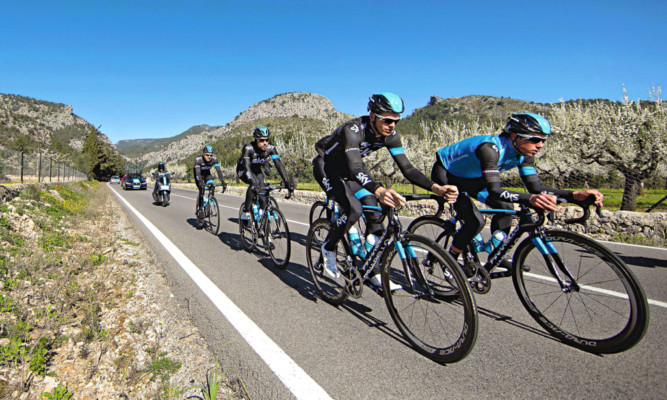
The daunting Sa Calobra climb is the most fearsome cycling challenge on Mallorca.
In English the name of the six-mile marvel of engineering translates as The Serpent.
With 26 hairpin bends at an average of 7% gradient, it rises just over a formidable 2,000 feet.
Every year, thousands of cyclists from all over Europe flock to the fabled ascent to try and conquer the ominous slithering road.
It’s not everyone’s idea of a relaxing holiday, but Mallorca has become THE destination for cyclists.
Day one of my “holiday” and it’s my turn to take on Sa Calobra.
At first the road leaves the shoreline and makes its way through a shaded section offering some protection from the sun.
But it doesn’t last long. Quickly you’re spat out on to the barren rocky terrain of the Sierra de Tramuntna mountain range, and fully exposed to the energy-sapping heat.
For the next 48 minutes at an average of just over seven painful miles an hour, pedal stroke after pedal stroke, I strained and struggled to get to the top. Drenched in sweat and exhausted, I made it to the top.
After the rigours of Sa Calobra I was able to recover at Iberostar’s flagship hotel in Playa de Muro.
This stunning facility has regularly catered for pro cycling squads like Team Sky, Scottish sponsored NetApp Endura, and Saxo Tinkoff, team of former Tour de France winner Alberto Contador.
Last year it hosted an astonishing 90,000 cycling bookings.
It has 2,000 high quality bikes for rent and during the season 45 guided cycling tours leave daily to ensure everything the island has to offer is easily accessible.
Weary cyclists can also use a recovery spa with ice baths, Jacuzzis, steam rooms and saunas.
Menus in the hotel’s two huge dining rooms are tailored to aid your nutritional needs and provide the fuel needed to keep racking up the miles.
Out of the saddle, Mallorca has more to offer. In the north east of the island is the ancient town of Arta which is at least 3,000 years old.
Its stunning main attraction is the hilltop fortress of Santuari de Sant Salvador which dominates the skyline and from its battlements offers stunning views of the Llevent nature reserve below.
Just a few miles from Arta tucked away at the end of cypress tree-lined avenue is the picturesque Ermita de Betlem monastery.
The short journey to get to the church from town is worth the effort alone.
The meandering road takes you out of Arta heading towards the coastline before dropping down to the tranquil spot.
Another town worth seeking out is Petra, birthplace of Mallorca’s most famous son, Junipero Serra, the Franciscan friar who established the American cities of San Diego and San Francisco.
Petra is a sleepy town almost in the centre of the island and well off the usual tourist trail. At its heart is a main square surrounded by cafes, restaurants and bars which offer a great spot for a relaxing drink.
Mallorca is crammed full of good places to eat serving traditional speciality dishes such as om amb col (pork wrapped in cabbage) or frit mallorqui (fried offal). Suckling pig and lamb are other regulars on menus.
Hidden away in Port de Pollenca is the tiny La Celtika restaurant, a must if seafood is your thing.
Run by just two people, the Breton chef delivers outstanding dishes using the best local produce that can be washed down by the local wine which is undergoing a huge renaissance in popularity.
Pollenca itself is very popular with the cycling fraternity and on the road into the town is Tolos.
Inside its walls are adorned with regular visitor Sir Bradley Wiggins’ cycling jerseys, as well as one of his bikes hanging from the ceiling.
Outside its large terrace offers a cracking spot for a cold beer and views across the beach and harbour that stretches out across the horizon.
You don’t have to be a cyclist to enjoy the Balearic beauty of Mallorca, but riding your bike offers one of the best ways to make the most of the island.

Enjoy the convenience of having The Sunday Post delivered as a digital ePaper straight to your smartphone, tablet or computer.
Subscribe for only £5.49 a month and enjoy all the benefits of the printed paper as a digital replica.
Subscribe